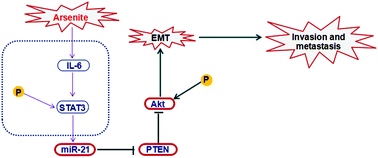MicroRNA-21 activation of Akt via PTEN is involved in the epithelial–mesenchymal transition and malignant transformation of human keratinocytes induced by arsenite
Abstract
MicroRNAs are involved in the epithelial–mesenchymal transition (EMT) and malignant transformation of cells. However, the molecular mechanisms remain unclear. In seeking new biomarkers of chemical exposure in the risk assessment of arsenite-induced skin cancer, the function of microRNA-21 (miR-21) in the regulation of serine/threonine kinase (Akt) activation was investigated. Akt suppresses phosphatase and tensin homolog (PTEN) and is involved in neoplastic and metastatic properties of arsenite-transformed human keratinocyte (T-HaCaT) cells. In HaCaT cells, arsenite caused an increase of miR-21 levels and a decrease of PTEN, which activated Akt signaling and induced the EMT. On inhibiting miR-21, the levels of PTEN were increased, and activation of Akt was blocked. Knock-down of PTEN by siRNA enhanced the activation of Akt. The effects of an miR-21 inhibitor on Akt activation were antagonized by PTEN siRNA. In T-HaCaT cells, blocking the activation of Akt by LY294002 inhibited the EMT. Moreover, the effects of an miR-21 mimic on the EMT and the neoplastic capacity, invasion, and metastasis of T-HaCaT cells were antagonized by LY294002. T-HaCaT transfected with PTEN plasmids showed decreased Akt activation and E-cadherin expression and increased vimentin levels. Thus, activation of Akt, controlled by miR-21/PTEN, is involved in the EMT, and thereby affects the neoplastic, invasion, and migratory capacities of T-HaCaT cells. The results point to the potential use of miR-21 as a biomarker for skin cancer and as a target for cancer prevention and treatment.


 Please wait while we load your content...
Please wait while we load your content...